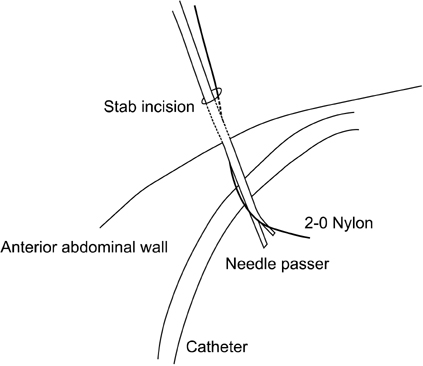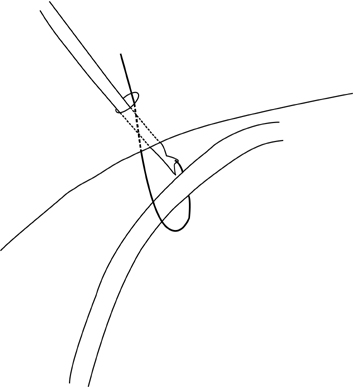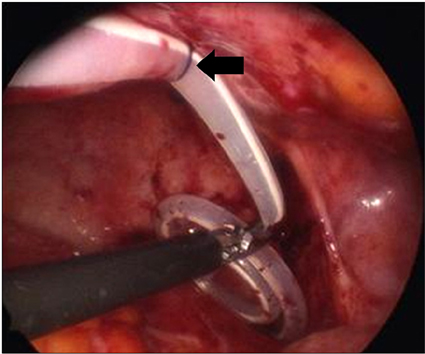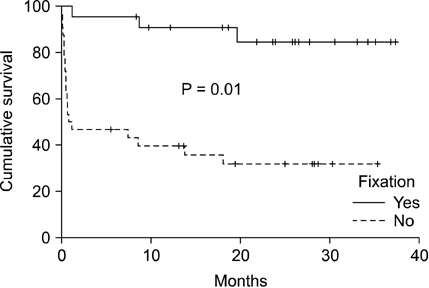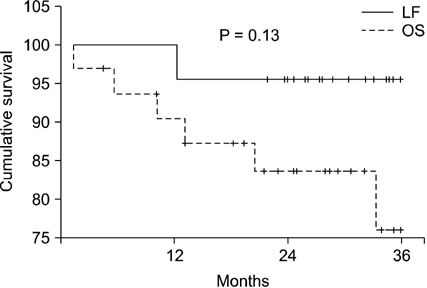J Korean Surg Soc.
2012 Dec;83(6):381-387. 10.4174/jkss.2012.83.6.381.
Laparoscopic internal fixation is a viable alternative option for continuous ambulatory peritoneal dialysis catheter insertion
- Affiliations
-
- 1Department of Surgery, Gachon University Gil Medical Center, Gachon University of Medicine and Science, Inchon, Korea. calzevi@gmail.com
- 2Department of Nephrology, Gachon University Gil Medical Center, Gachon University of Medicine and Science, Inchon, Korea.
- KMID: 1437536
- DOI: http://doi.org/10.4174/jkss.2012.83.6.381
Abstract
- PURPOSE
One of the major drawbacks of peritoneal dialysis (PD) is catheter migration and dysfunction. Preventing catheter migration is one of the main concerns. We compared laparoscopic internal fixation method with open surgical method for catheter migration rates.
METHODS
From January 2008 to August 2009, PD catheters were inserted by laparoscopic fixation (LF) method in 22 patients and by open surgery (OS) in 32 patients. Clinical data were reviewed retrospectively. The frequency of migration, peritonitis, and other complications were compared. Catheter and patient survival rates were also compared.
RESULTS
The mean age and sex ratio were not different between groups. Mean follow-up duration was 29.1 months in LF group and 26.1 months in OS group. More patients in LF group (27.3%) had history of laparotomy than in OS group (3.1%) (P = 0.01). The mean operation time was significantly longer in LF group (101.6 +/- 30.4 minutes) than in OS group (72.4 +/- 26.03 minutes) (P = 0.00). The cumulative incidence of catheter migration was 65.6% in OS group and 13.6% in LF group (P = 0.00). Migration-free catheter survival was higher in LF group (P = 0.001). There were no differences in complication rates between groups. Overall catheter survival was similar (P = 0.93). Patient survival rate at 2 years was not different (P = 0.13).
CONCLUSION
Laparoscopic internal fixation of continuous ambulatory peritoneal dialysis catheter significantly reduces migration rates without any addition of complications. Also, laparoscopic technique did not incur patient morbidity or mortality despite the requirement for general endotracheal anesthesia and longer operation time. Therefore, internal fixation can be afforded safely in patients with previous abdominal surgery as either a salvage or preventive measure in patients with repeated catheter migration.
Keyword
MeSH Terms
Figure
Reference
-
1. Bailie GR, Eisele G. Continuous ambulatory peritoneal dialysis: a review of its mechanics, advantages, complications, and areas of controversy. Ann Pharmacother. 1992. 26:1409–1420.2. Steinberg SM, Cutler SJ, Nolph KD, Novak JW. A comprehensive report on the experience of patients on continuous ambulatory peritoneal dialysis for the treatment of end-stage renal disease. Am J Kidney Dis. 1984. 4:233–241.3. Kimmelstiel FM, Miller RE, Molinelli BM, Lorch JA. Laparoscopic management of peritoneal dialysis catheters. Surg Gynecol Obstet. 1993. 176:565–570.4. Kittur DS, Gazaway PM, Abidin MR. Laparoscopic repositioning of malfunctioning peritoneal dialysis catheters. Surg Laparosc Endosc. 1991. 1:179–182.5. Soontrapornchai P, Simapatanapong T. Comparison of open and laparoscopic secure placement of peritoneal dialysis catheters. Surg Endosc. 2005. 19:137–139.6. Dombros N, Dratwa M, Feriani M, Gokal R, Heimburger O, Krediet R, et al. European best practice guidelines for peritoneal dialysis. 4 Continuous ambulatory peritoneal dialysis delivery systems. Nephrol Dial Transplant. 2005. 20:Suppl 9. ix13–ix15.7. Wright MJ, Bel'eed K, Johnson BF, Eadington DW, Sellars L, Farr MJ. Randomized prospective comparison of laparoscopic and open peritoneal dialysis catheter insertion. Perit Dial Int. 1999. 19:372–375.8. Leblanc M, Ouimet D, Pichette V. Dialysate leaks in peritoneal dialysis. Semin Dial. 2001. 14:50–54.9. Gadallah MF, Pervez A, el-Shahawy MA, Sorrells D, Zibari G, McDonald J, et al. Peritoneoscopic versus surgical placement of peritoneal dialysis catheters: a prospective randomized study on outcome. Am J Kidney Dis. 1999. 33:118–122.10. Gokal R, Alexander S, Ash S, Chen TW, Danielson A, Holmes C, et al. Peritoneal catheters and exit-site practices toward optimum peritoneal access: 1998 update. (Official report from the International Society for Peritoneal Dialysis). Perit Dial Int. 1998. 18:11–33.11. Yilmazlar T, Kirdak T, Bilgin S, Yavuz M, Yurtkuran M. Laparoscopic findings of peritoneal dialysis catheter malfunction and management outcomes. Perit Dial Int. 2006. 26:374–379.12. Jwo SC, Chen KS, Lee CC, Chen HY. Prospective randomized study for comparison of open surgery with laparoscopic-assisted placement of Tenckhoff peritoneal dialysis catheter: a single center experience and literature review. J Surg Res. 2010. 159:489–496.13. Ash SR. Chronic peritoneal dialysis catheters: overview of design, placement, and removal procedures. Semin Dial. 2003. 16:323–334.14. Simkin EP, Wright FK. Perforating injuries of the bowel complicating peritoneal catheter insertion. Lancet. 1968. 1:64–66.15. Devine H, Oreopoulos DG, Izatt S, Mathews R, DeVeber GA. The permanent Tenckhoff catheter for chronic peritoneal dialysis. Can Med Assoc J. 1975. 113:219–221.16. Giannattasio M, De Maio P, La Rosa R, Balestrazzi A. Videolaparoscopy: a new alternative for implantation of peritoneal catheters in ESRD patients with previous abdominal surgeries. Perit Dial Int. 1996. 16:96–97.17. Brandt CP, Franceschi D. Laparoscopic placement of peritoneal dialysis catheters in patients who have undergone prior abdominal operations. J Am Coll Surg. 1994. 178:515–516.18. Jwo SC, Chen KS, Lin YY. Video-assisted laparoscopic procedures in peritoneal dialysis. Surg Endosc. 2003. 17:1666–1670.19. Ogunc G, Tuncer M, Ogunc D, Yardimsever M, Ersoy F. Laparoscopic omental fixation technique versus open surgical placement of peritoneal dialysis catheters. Surg Endosc. 2003. 17:1749–1755.20. Carrillo SA, Ghersi MM, Unger SW. Laparoscopic-assisted peritoneal dialysis catheter placement: a microinvasive technique. Surg Endosc. 2007. 21:825–829.21. Yun EJ, Meng MV, Brennan TV, McAninch JW, Santucci RA, Rogers SJ. Novel microlaparoscopic technique for peritoneal dialysis catheter placement. Urology. 2003. 61:1026–1028.22. Ogunc G. Videolaparoscopy with omentopexy: a new technique to allow placement of a catheter for continuous ambulatory peritoneal dialysis. Surg Today. 2001. 31:942–944.23. Daschner M, Gfrorer S, Zachariou Z, Mehls O, Schaefer F. Laparoscopic Tenckhoff catheter implantation in children. Perit Dial Int. 2002. 22:22–26.24. Batey CA, Crane JJ, Jenkins MA, Johnston TD, Munch LC. Mini-laparoscopy-assisted placement of Tenckhoff catheters: an improved technique to facilitate peritoneal dialysis. J Endourol. 2002. 16:681–684.25. Crabtree JH, Fishman A. Laparoscopic omentectomy for peritoneal dialysis catheter flow obstruction: a case report and review of the literature. Surg Laparosc Endosc Percutan Tech. 1999. 9:228–233.26. Nielsen PK, Hemmingsen C, Friis SU, Ladefoged J, Olgaard K. Comparison of straight and curled Tenckhoff peritoneal dialysis catheters implanted by percutaneous technique: a prospective randomized study. Perit Dial Int. 1995. 15:18–21.27. Comert M, Borazan A, Kulah E, Ucan BH. A new laparoscopic technique for the placement of a permanent peritoneal dialysis catheter: the preperitoneal tunneling method. Surg Endosc. 2005. 19:245–248.
- Full Text Links
- Actions
-
Cited
- CITED
-
- Close
- Share
- Similar articles
-
- Peritoneal-pleural leak improved by switching from continuous ambulatory peritoneal dialysis to automated peritoneal dialysis
- Comparison of the Laparoscopic and Open Peritoneal Dialysis Catheter Insertion in Children
- Laparoscopic Continuous Ambulatory Peritoneal Dialysis (CAPD) Catheter Insertion in Children: Early Experience Comparison with Open CAPD Catheter Insertion
- A new connecting technique in partial replantation of a ruptured peritoneal dialysis catheter
- Flavimonas oryzihabitans Peritonitis in Patients with Continuous Ambulatory Peritoneal Dialysis: Report of 2 cases

